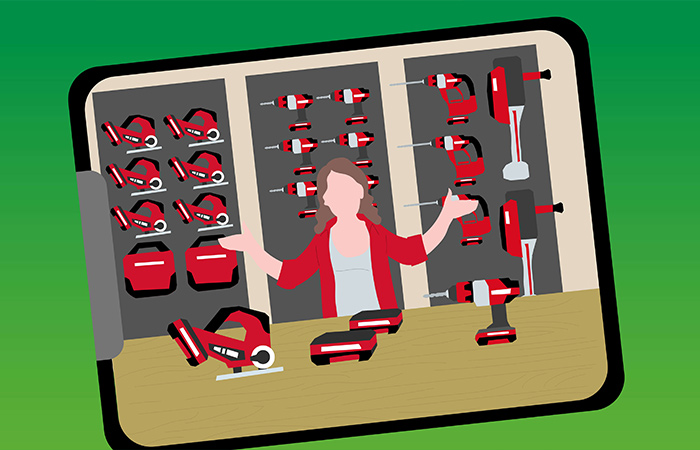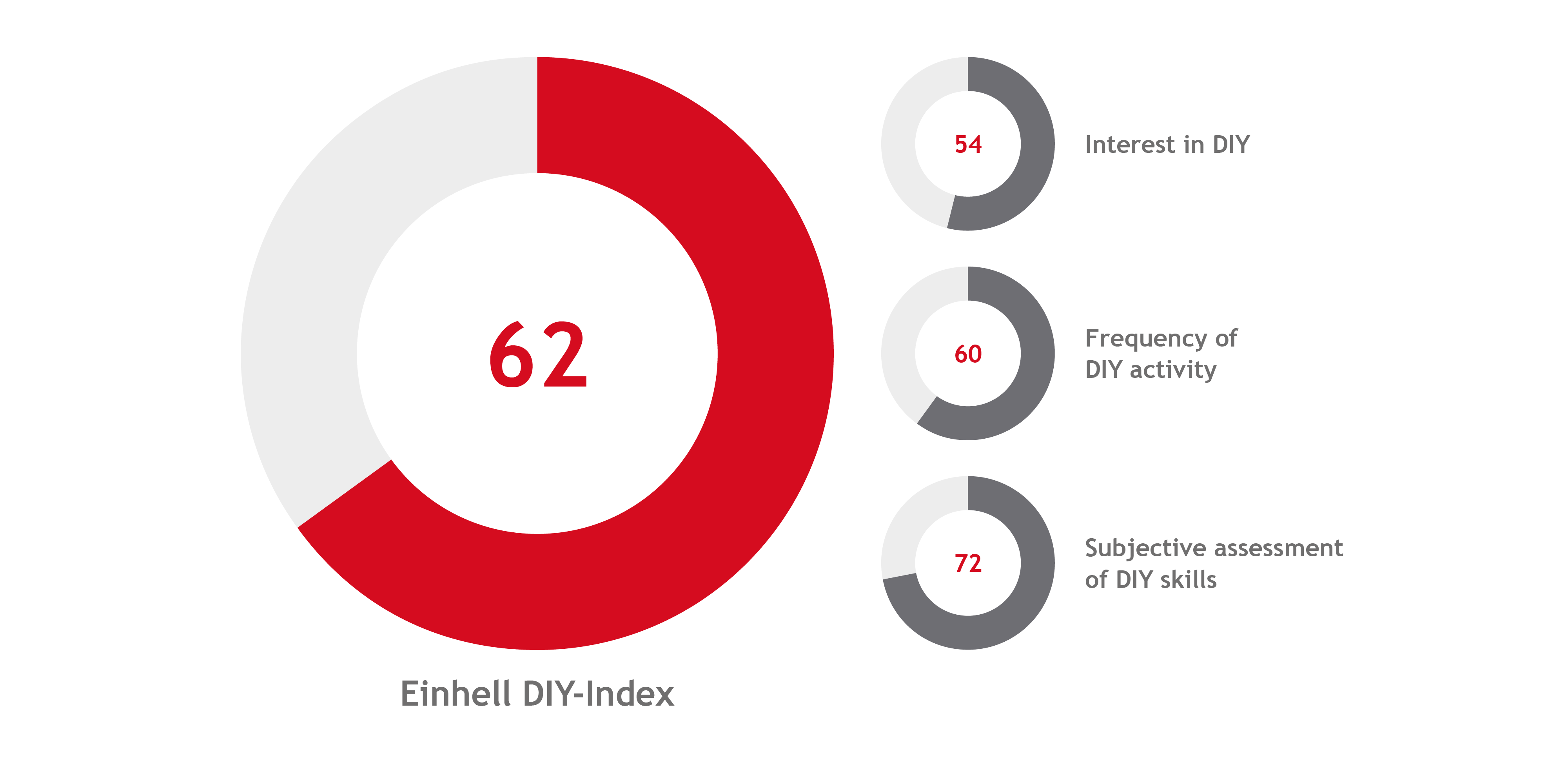Einhell Do-It-Yourself Study 2023
Workshop, Home and Garden Trends
Einhell Germany AG, the leading supplier of garden and DIY tools, joined forces with the SINUS Institute to conduct a representative survey of more than 2,000 participants exploring what the German population think about doing things themselves in the workshop, home and garden. What motivates them to do so, what puts them off? How do they rate their DIY skills? What jobs do they reckon they can do themselves? What tools do they use, and what do they look out for when buying them? What role do cordless tools play? How much money do they spend on them? The answers are supplied in the Einhell Do-It-Yourself Study 2023. The Einhell DIY Index obtained in parallel gives a snap summary of the affinity of Germans for DIY in a single figure.
The study setting
The basis of the study is a standardized survey of 2,170 people aged between 18 and 69 from a representative cross-section of the population by age, sex and education using the CAWI (computer-assisted web interviews) method.

Many different purchase criteria
When it comes to buying tools for DIY and gardening, thinking tends to be dominated by the aspects of long product life, user friendliness and handling and, with cordless tools, the battery life. Other important criteria include top quality and performance. The product, quite simply, has to offer a good price-performance ratio. The most frequent sources of information prior to the purchase of a DIY tool are web research and online clips, followed by personal recommendations and visits to DIY stores. The younger generation prefers using online channels such as social media, web forums and blogs, and online reviews.
Switch to cordless tools
The trend towards cordless tools is in full swing, with 80 percent of households already owning a cordless screwdriver and almost half using a cordless jigsaw. Older respondents are still somewhat cautious about buying cordless tools, a cordless (drill) driver being the tool most often used and owned. The younger generation is much more open to batteries: They are more often willing to spend greater amounts on cordless tools and, in contrast to their older counterparts, already tend to own more battery-operated than corded or petrol-driven tools. Other important criteria include top quality and performance.


Motives for doing-it-yourself
The German population is highly motivated to do little jobs around the home and garden themselves, with more than half of Germans enjoying spending time DIYing and gardening and always on the lookout for new projects. The motives given for this activity include independence, self-fulfillment and self-affirmation especially. One of the main factors is “Being able to do something for myself” (87 %), closely followed by “Being able to solve problems without help from someone else” (84 %). Apart from lack of time, those questioned had little against DIY activities.
Can she fix it? Yes she can!
The motives for doing-it-yourself have little to do with the sex, age or education of the respondents. Women are highly motivated at DIY: 86 percent, for instance, want to be able to resolve problems in the home and garden without help from anyone else. Men are often more experienced than women, particularly with DIY jobs, and accordingly more self-confident. This is less true for gardening, where there is usually very little difference between men and women in terms of experience and self-confidence. For women, though, the opportunity to spend time by themselves and the possibility of doing something creative and artistic are more important than for men. Women are also a few percentage points more motivated for all DIY activities.


DIY is in
As for the tools used, cordless (drill) drivers (91 %) and lawn mowers (89 %) have now become indispensable. Other equipment includes tools such as jigsaws, grass trimmers, wet & dry vacs, and hedge trimmers. The great majority of people in Germany reckon they have some DIY skills, with 72 percent confident they can assemble an item of furniture following the manufacturer's instructions. More demanding jobs such as renovating a bathroom and drywall work are something that a respectable 19 percent think they could tackle. The Germans also consider themselves capable gardeners: The majority find it easy to mow the lawn, dig and hoe soil, and cut branches. Even things like felling trees, building a pond or installing a fountain, though, would not be too much of a challenge for many.
Einhell Do-It-Yourself Study 2023
Einhell Do-It-Yourself Study 2023 (German version only)
PDFThe SINUS Institute
The SINUS Institute is an independent, owner-managed institute for market and social research, with locations in Heidelberg and Berlin. Applying ethnological curiosity, empathy, respect, scientific reliability and, last but not least, more than 40 years of experience, SINUS explores people’s everyday realities, analyzes socio-cultural change, and interprets its significance for companies and institutions.
The institute’s research fields cover a huge area, from wristwatches all the way to future scenarios. A core competency of SINUS is the development of strategic target group concepts. SINUS develops customized target group typologies along the relevant attitudinal dimensions in the specific market, with special consideration given to future strategic potential and fundamental value patterns. Sinus works for leading brand manufacturers and for renowned public clients from politics, media and society (federal and state ministries, foundations, churches, associations, NGOs, etc.).

The Einhell DIY Index
In 2023 the Einhell DIY Index stands at 62 out of 100
The goal of the Einhell DIY Index is to track the future development of do-it-yourself at consumer level. The DIY Index was developed by the SINUS Institute in a wide-ranging empirical survey as part of the Einhell Do-It-Yourself Study. The Einhell DIY Index comprises the dimensions of interest in DIY, frequency of DIY activity, and subjective assessment of DIY skills.

Group-specific differences in the Einhell DIY Index

Methods
The Einhell DIY Index comprises the following dimensions:- Interest in DIY
- Frequency of DIY activity
- Subjective assessment of DIY skills
The Einhell DIY Index gives a general overview of the DIY sector. The scale goes from 0 to 100.
The basis of the study is a standardized survey of 2,170 people aged between 18 and 69 from a representative cross-section of the population by age, sex and education using the CAWI method. The survey was conducted from September 9 through 23, 2022.



